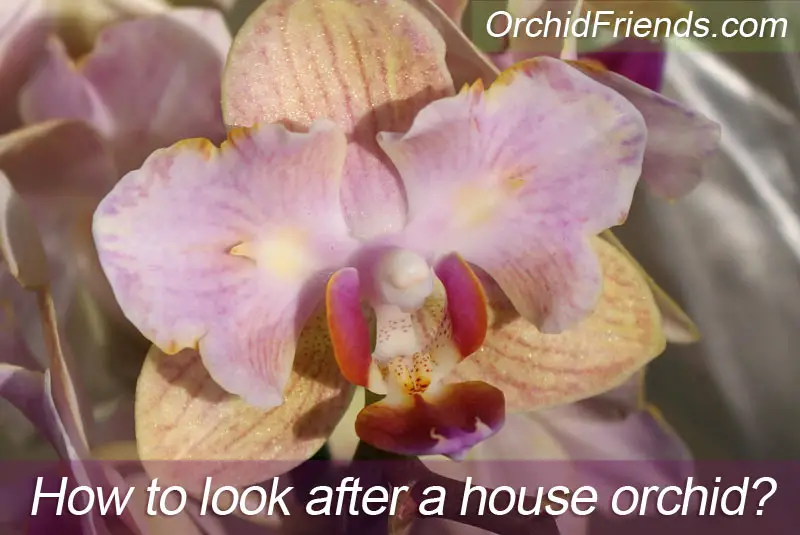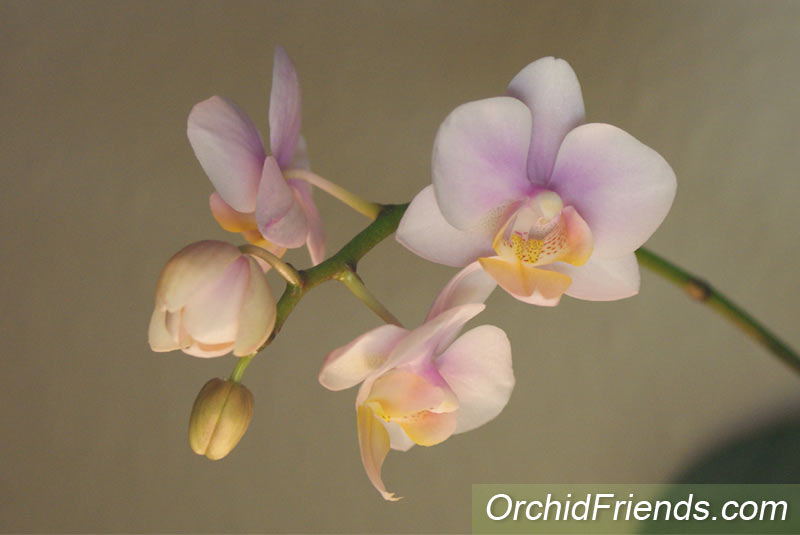
** This post is written and edited by a human being **
In recent years Phalaenopsis orchids, and orchids in general, have grown in popularity as indoor plants. They used to be harder to find and more expensive, but are widely available and affordable these days.
Phalaenopsis orchids have become the plant to give on anniversaries, Mother’s Day, birthdays, and even Christmas. But many people are left uncertain with how to care for their new orchid.
So what is the best way to look after an orchid house plant? Place the orchid in bright yet non-direct sunlight. Avoid cold drafts during winter periods. Water the plant as soon as the potting media has dried out. Never leave the orchid standing in water for long periods of time. Make sure the pot has enough airflow and drainage. Repot the orchid every few years. Fertilize as needed.

PLACEMENT
You want to find a spot in your house that gives your orchid plenty of light, but also shields it from getting burned.
South- and East-facing windows are preferred. There, your orchid can get the maximum amount of light the sun simply provides.
When summer approaches, keep an eye out for rising temperatures. If the sun becomes too hot, bring the orchid further inside the room, where it will be out of reach of the strongest rays.
You can also switch rooms during a heatwave if your orchid is on the South-facing window. Even though orchids shouldn’t be moved around too much because having to adapt to a new environment stresses them, you can do this to protect them from too much heat.
I used to have a white, thin cotton curtain that worked wonders with my windowsill orchids—it allowed enough sunlight to get through to the plants, but it also kept the strongest heat out. This is a useful trick if you do not wish to relocate your orchids.
During the summer, your biggest concern is excessive heat, but during cooler periods, you want to ensure that your orchid is not standing in a cold draft.
Phalaenopsis orchids can take cooler temperatures, which is also what prompts their bloom in the first place. But if you live in a climate with freezing temperatures, make sure you don’t keep the window open directly where your orchid is standing.
Orchids can get frostbites and even freeze to death. A cold draft can also cause the orchid to drop its flowers and buds—a phenomenon called “bud blast”, so keep this in mind when placing your orchids.
“Avoid any extreme temperature changes, hot or cold!”
If you live on a climate with very little natural daylight during autumn and winter, you might have to supplement your orchid with artificial lighting.
Look out for full-spectrum LED plant growing lights. Not sure if all garden shops carry them, but many pet and aquarium shops do as they’re also used for pet birds and reptiles. And of course, there’s the almighty internet if you can’t find them locally.
Optionally, normal fluorescent lights can work too. Just make sure they’re bright enough. Leaves and flower spikes always grow towards the strongest available light source, which is a good taleteller of the strength of your lights.

WATERING
How to water Phalaenopsis orchids is probably the question that gets asked the most. And no wonder – the number one killer of house orchids is insufficient watering; too much or too little.
Orchid watering methods differ from other house plants. This is because they’re “epiphytes”; plants that grow higher up attached to tree trunks and branches, instead of the ground in soil. So understandably, their roots are very different.
First thing to remember is to water the orchid only when needed. This varies depending on the season, your climate, and even your indoor air.
During hot days it could be once a week, and during cool seasons only once every three weeks. Just look at the potting medium inside the pot – if it’s completely dry it’s time to water again. But if the bottom medium is still wet or moist, wait a little longer.
The color of the roots is another good indicator for when to water; green and chunky roots are still moist, and don’t need watering. But if they’ve turned white or silvery and dry-looking, it’s time to water again.
There are a few different ways to water your orchid, but with each method, please always avoid getting water inside the plant’s crown. Water in the crown will lead to crown rot.
In the wild, Phalaenopsis orchids would grow sideways and upside-down, so their crown is protected from collecting water.
Indoor environment also lacks the same amount of air circulation and sun than what nature provides, so water buildups struggle to evaporate.
One way to water your orchid is the “soaking method”. Put some lukewarm water in a bucket or kitchen sink, and put the orchid pot to stand there – the water reaching only about half up the pot.
Leave the orchid to soak for 15 minutes or longer. Once the time is up, lift up the orchid and let the excess water drip out, before putting it back to its place.
This watering method gives enough time for bigger bark pieces to soak up enough water.
You can also water your orchid under a running tap. Let the lukewarm water run only on the potting mix, carefully protecting the crown from getting wet. This is a quick way to water your orchid, and works if you’re using finer potting mixes.
Some people water their orchids the same way “normal” houseplants are watered – by pouring water straight into the pot without moving it anywhere. This is fine as long as you make sure no excess water is left standing in the pot! Standing water will quickly lead to root rot.
What kind of water to use? You can use tap water, distilled water, rainwater, or even aquarium water. The quality of tap water varies from area to area, but many people use it successfully.
Some people let the tap water stand overnight before using it because that allows the chloramine in the water to evaporate. (Chloramine is a chemical disinfectant used to clean the water when it comes through the pipes)
You can also boil the tap water before using it. Boiling kills bacteria, so you’re sterilizing the water before giving it to your orchids. Just let it cool down before using it.
Distilled and rain waters are 100% pure waters, but on the downside that also means they lack any minerals. So when using them to water your orchids with, you must add mild fertilizer to them.
To read more about how to water your orchid, please see HERE
ICE CUBES
Some people water their orchids with ice cubes – one big orchid company has even made it its brand. This topic has caused a lot of (heated) discussion in the orchid community.
Phalaenopsis orchids are tropical plants, and therefore never experience freezing temperatures. They’re sensitive to sudden environmental changes, and can’t be watered with ice cold water.
Therefore, many orchid growers believe that putting ice cubes on orchid roots stresses the plant and is more damaging than anything else.
Personally, I’ve never put ice cubes on any of my orchids – not even as an experiment. Would I advice someone new to orchids to do so? No, I wouldn’t. However, I know there are people out there who claim to have used this method successfully for years, so who am I to say it can’t work?
However, most of these people live on hot and humid climates, like Florida, so perhaps the ice cubes simply melt so fast they don’t get to damage the roots.

Another concern about watering with ice cubes, is that you can’t control the amount of water your orchid needs. Different seasons require different amounts of water – more during hot seasons, less during cold seasons – so how is this achieved when the same amount of ice cubes is always given? (Many “ice-cubers” say they always give the same amount, regardless of the season)
As I mentioned above, this is a controversial topic in the orchid community. Personally, I wouldn’t advise doing it, but if there are people who claim to have done it successfully, then maybe it can work for some people in certain climates.
If you choose this watering method, keep an eye on your plants and change the method if you see your orchids might be struggling.

FERTILIZER
Do you need it? How often? Some people give it, some people don’t. As mentioned above, if you opt for distilled or rain water, you must add fertilizer when watering. But when using tap water, it’s up to you if you want to fertilize or not.
You can do “weekly, weakly”, once a month, or a few times a year. You can even do it only during the orchid’s growth period, which start after the blooms have withered.
Either way, whenever using fertilizers always read the bottle’s dosing instructions. Less is more! It’s enough to give only half of the recommended amount.
If you want to learn more about fertilizing your orchids, please see HERE
And for homemade orchid fertilizer recipes, please see HERE
AIRFLOW
As orchids are “air plants” their roots need to breath, so to say. They would suffocate without enough airflow inside the pot. Old potting media compresses with time, blocking proper airflow. Also too shielding decorative pots can block it.
Always keep an eye on the pots; if you notice the potting media struggles to properly dry out even during warmer seasons, or if it appears too compact, you can be pretty sure there’s a lack of proper airflow.
Depending on the cause, adding air holes on the sides of the pot, or taking it out of the decorative pot, can solve the issue. In case of compacted (old) potting media, you need to repot your orchid.
REPOTTING
House orchids need to be repotted every few years, preferably during spring or summer. You know your orchid needs repotting when;
- The potting media is old and compacted
- When the orchid roots have outgrown the pot
When repotting due to outgrown roots, only a slightly bigger pot is needed. Orchid roots don’t need lots of extra space, so don’t go crazy with the size when selecting a new orchid pot. If the orchid roots still fit in the old pot, you don’t even need to buy a new one – just put it back in its old pot!
With potting mixes, there are many ready orchid potting mixes available – they’re a safe choice for beginners. Otherwise you can choose from different sized bark pieces, moss, perlite, even charcoal. Different surroundings favor different orchid mediums; fast drying mediums are better for more humid environments and vice versa.
However, there’s no need to overcomplicate this just yet. If you’re still new to orchids, keep it simple. Ready orchid potting mixes and medium-sized bark pieces work great with most house orchids! Once you become more experienced with orchids, you can start to experiment with different types of potting mediums.
To read more about different types of orchid potting mediums, please see HERE
For a step-by-step guide on how to repot your orchid, please see HERE
MISTING
Many people ask if they should mist their house orchid. It’s true that orchids love humidity, being exotic plants. But misting requirements really depend on your growing environment. If your indoor air is very dry, below 40%, you can gently mist your orchid every now and then.
Optionally, you can place a bowl/tray of water close to your orchids for extra humidity. (More about humidity trays HERE) Some people keep their orchids close to the aquarium for this very reason! And others buy a professional air humidifier.
But if your indoor air is humid enough (>40%) and your orchid seems to be thriving, then there’s no need for extra humidity.
I recently bought an air humidity reader (hygrometer), so I always know how humid it is in my orchid room. Today, for instance, it shows 67% humidity, which is higher than normal (it’s been a rainy day). Orchids love as much humidity as there simply is, but you’re good at >50-60% humidity.
In addition to humidity, it’s important to have proper air circulation in the room. Stagnant humid air can quickly lead to rotting problems.
Orchid care after flowering
Sadly many Phalaenopsis orchids are treated disposably. Once they’re done flowering they get thrown out. This could be partly due to the throwaway culture we live in, but there’s also a misconception that orchids die after they’re done flowering.
This, of course, couldn’t be further from the truth. Phalaenopsis orchids can live many years, even decades, with the right care. And they also bloom again and again, sometimes even more than once a year.
When the house orchid is done flowering, it will enter the dormancy stage. During this time it will focus its energy on growing new roots and leaves. You can give fertilizer to your orchid during this time, if you wish, for an extra boost.
There are orchid fertilizers that are made specifically for this growth period. But even general house plant fertilizers and orchid fertilizers can be used.
Now that your orchid is done flowering, you can also repot it if necessary.
Orchid care after repotting
People often ask how to care for the orchid after it’s been repotted. This is the time when your orchid will adjust to its new growing media, and starts to grow new roots and leaves. So you don’t need to do much – just let the orchid do its thing!
Some people refrain from watering the orchid for 1-2 weeks after repotting, but others water it immediately after repotting. Whether you should do this or not, depends on who you ask from.
Personally, I always water the orchid immediately after repotting, and it has worked for me. But it’s up to you, there’s no right or wrong.
Other than that, just let your freshly repotted orchid be, and water it as usual in the coming months. You should be seeing new roots and leaves starting to grow soon!
Conclusion:
I hope this article has helped you with how to look after your orchid house plant. Even though orchids are different and have their own little quirks, they’re really not that hard to care for once you’ve learned the few dos and don’ts.
Phalaenopsis orchids are also the easiest orchids to keep out of all commercial orchids. In fact, they’re considered as the perfect beginner orchid.
I got my first ever orchid accidentally. I was taking some garbage out and saw a perfectly fine orchid (with the blooms and all) in the container. Of course I couldn’t leave it there – it was beautiful, and I don’t believe in throwing out perfectly fine plants. So I brought it home and that was the beginning of my orchid journey.
I can tell you, though; I knew nothing about orchids back then. Not how to water them, where to keep them, nothing… But that’s how it all started. And there were many more orchids and learning to follow!
That’s also the reason why I want to share my knowledge with you now, because I’ve been there too! I know how confusing it can feel in the beginning, as orchids really don’t come with ready care manuals.
Thank you for reading. I wish you all the best with your orchids! If you have any questions or comments, feel free to leave them below in the comment section.
Bye for now, orchid friends!




